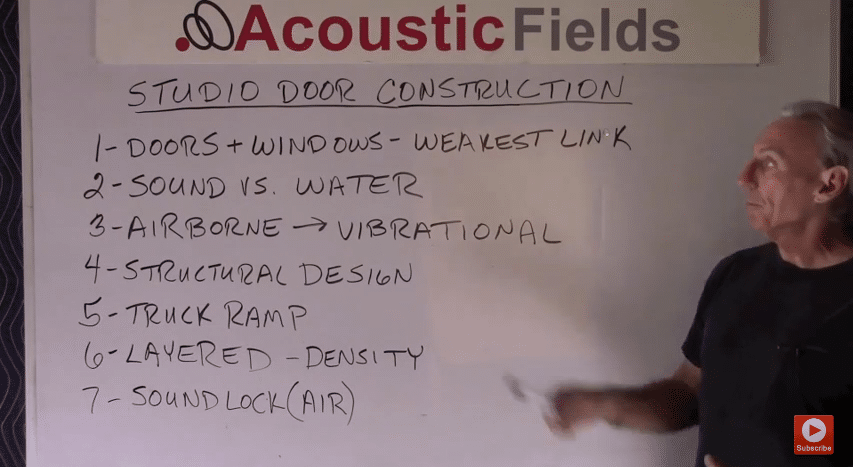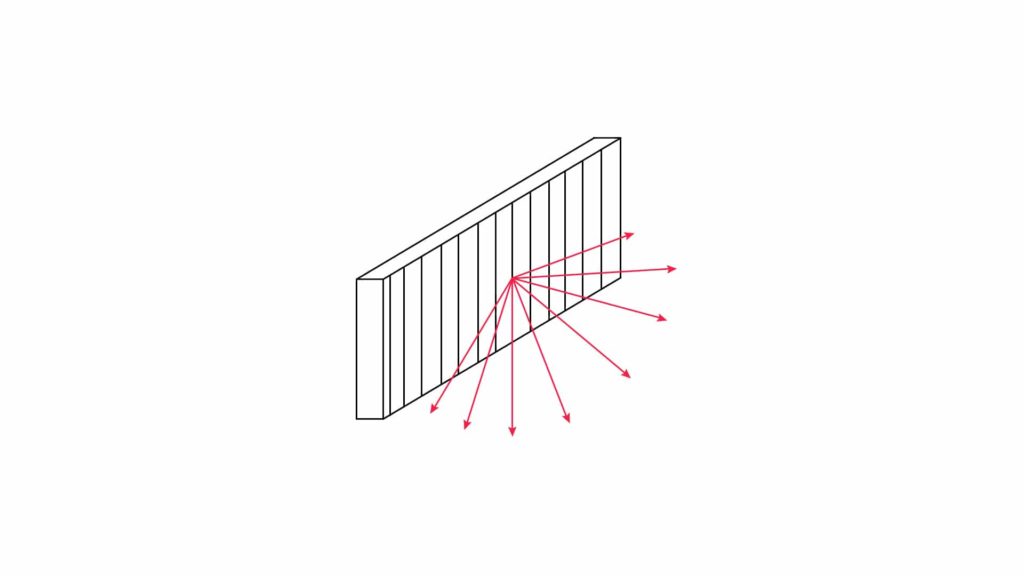We’re going to talk today about studio door construction. We get a lot of inquiries about how to do the doors in your studios, listening rooms, things like that, music rooms, live rooms. Most people have some knowledge about what to do with the walls and the ceilings and the floors but when it comes to the door construction and what to do there, they’re a little confused. Hopefully, this will clarify a little bit for you.
Remember that your doors and your windows are the weakest link in the whole room. Sound is like water. It will find the smallest hole or the weakest density within your structure to go through especially though frequency energy. We have to be very, very careful and make sure we first have no holes but we also have to make sure that we have the right density in our construction methods especially with low frequencies.
A common thing today I hear a lot about is this two sheets of drywall green glue, the resilient clips as technology to install in your walls. Well, this is a good technology for frequencies above 125 hertz. It really doesn’t do much below 125 hertz.
We had a customer the other day who built his home theater room using this and he was very unhappy that the low frequency energy was coming through into the adjacent rooms next to his home theater. The above 125 hertz method that he used was working for the middle and high frequencies but not for the lows. You have to be very careful. Density is critical when it comes to low frequencies.
We’re taking airborne energy with our doors. We’re converting it to vibrational energy. The energy moves through the air. It strikes the structure and then the structure starts moving. We got vibrations to deal with so with airborne to structure. Two different kinds of physics. Two different kinds of energies. Some similarities in the physical side of it and the science of it but lot of differences and those differences are critical. We have to remember that it’s a vibrational issue when it comes to our doors.
You must design the door to have at least the same density as the rest of the surface area of the room or remember, sound is like water. It will find the weakest link and get through. You have to be very, very important, very, very critical with the design here. We had a client who did pour concrete for his shell, did a really good job on the interior design of his walls but he left the doors that came with the property in place.
He was very unhappy that all the energy was coming through the doors. Well, sound is like water. It finds the weakest link and the door was the weakest density because he had concrete and two by eight stud frame with treatment inside of it. He had the right combination of flexibility and rigidity in his structure but he left the standard … I think it was a hollow core door even if I remember, it serve me correctly.
You have to be very careful here. Density is critical in the whole situation. That could be obtained, that was structural design. You can do that. If you have any doubts about that, contact me. I could help with this. I built hundreds of doors, different designs, tested most of them and can give you an idea on your particular situation.
What are doing in the design aspect of it? We’re using a layered approach because remember, we’re taking airborne energy striking the surface and then it’s converting to structural or vibrational energy. If ever driven on a freeway and you’re in the mountains and there’s a steep grade and you’re going down the grade and they have what’s called a truck ramp, if the trucks go down the grade with a big load and they lose their brakes or their brakes fail, they can pull over to the side and they have a truck ramp.
What’s the truck ramp do? It raises the elevation so that the energy from the truck going up the hill bleeds off. Then if you remember, usually at the end, there’s a big pile of sand or something or like that. There’s still a forward momentum, the truck will stop by hitting the sand file or whatever they have at the end.
It says bleeding of energy that we have to accomplish in our door. How do we accomplish that bleeding of energy? We uses series of layers of materials. The materials each have different densities. It’s the arrangement of those materials. What densities those materials have and how you put them together so you can build your truck ramp, so to speak.
Slow that energy down. You’re never going to get 100%. You’re going to manage it. Remember, containment management. Please don’t use that word soundproofing because there’s really no such thing. We just do the best we can. We managed and we can get really close. You can get below audibility and below the usage of the room. It’s not that complicated but there is some science involved in how you layer it, how you assemble it. It’s critical.
Any questions on that, just contact me. I can give you some ideas. I have some graphics of doors that we designed. I can help you with. We’re using the layered approach and want to slow that energy down. We use the layered approach with different densities.
Sound lock or air lock is another principle that people use. They use two doors with an airspace between it. Well, that’s just series of layers. Two doors, air, air is a layer, air is a material that you can use for sound absorption. All kinds of ways to go about this but density is critical. Don’t forget that sound is like water and you must be able to keep all that in mind when you’re dealing with it.
In graphic number three, we see that we’re converting airborne energy into structural vibration. It all take different sciences, different technologies to work with. Graphic four shows us that doors should be a layered combination when you’re dealing with vibration, it’s like layers. You need layers of different materials.
Keep all of these in mind when you’re building your studio door construction. If you have any questions about it, just feel free to contact me and I’ll give you the benefits of all the building that we’ve been doing.
In Summary
To learn more about room acoustics please sign up to download our free ebooks and video series on room acoustics here. And please let me know if you have any questions at any time.
Thanks
Dennis Foley








